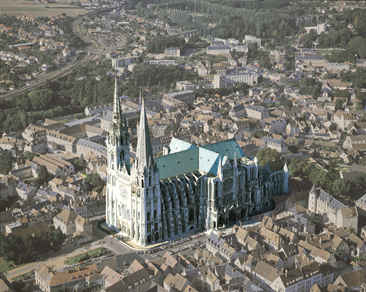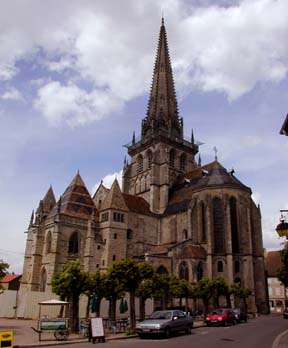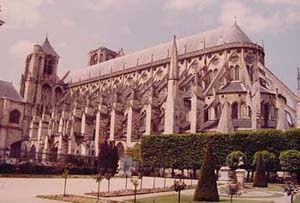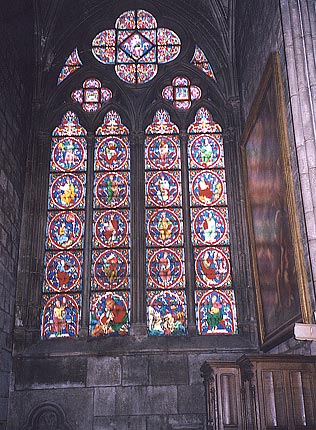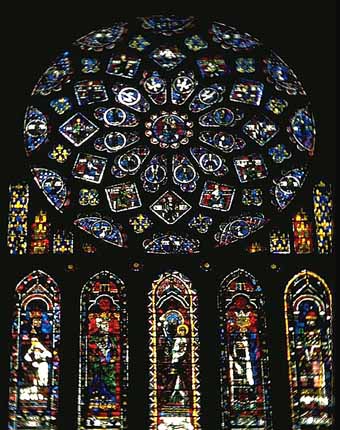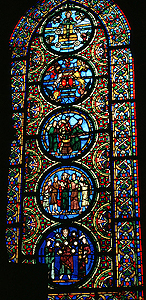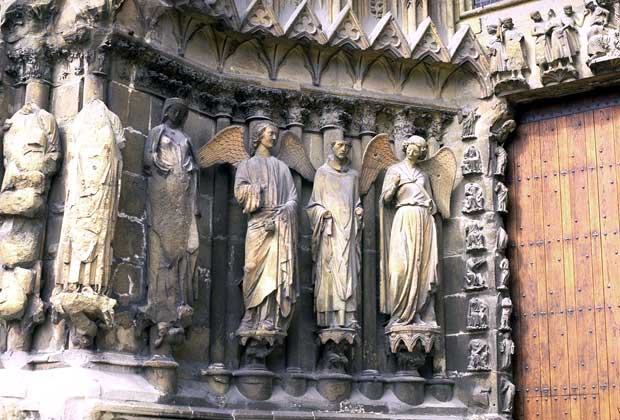Romanesque and Gothic Cathedrals
In France, le style Roman (the Romanesque style) lasted from the 9th century A.D. until the 12th century A.D., when architechture began to make a transition to le style Gothique (the Gothic style). The transition was apparent; the differences between le style Roman and le style Gothique were very distinct. Chartres Cathedral offered a good example of the differences, because it was being built as the styles made their transition, and therefore included elements of both eras. (Chabot, 2003)
Le style Roman, being the first of the two styles, was less advanced. The cathedrals were limited in size, and could never reach more than a few stories. This is because there was not a lot of support to hold the building up, and the higher a building was, the harder it was to support. Walls in le style Roman were very thick, massive, and made of stone to support the roof. In early Romanesque cathedrals, the roofs were wooden, and were sometimes supported by pillars on the inside of the cathedral. Later Romanesque cathedrals had rounded, stone vaults for ceilings (Chabot, 2003).
Because of the thick walls, windows in le style Roman had to be little and thin, so they did not comprimise the strenth of the walls. Large gaps in the stone would weaken the support for the roof. Later Romanesque Cathedrals put clear glass into the windows as well. Romanesque windows were rounded on top. (Chabot, 2003)
Sculptures and carvings were used in le style Roman to tell bible stories and to show royalty. Pictures, not words, had to be used because most of the people were illiterate. The people in the Romanesque artwork were usually stiff, expressionless, and unrealistic, and were either elongated or squat. Other images used in sculptures and carvings of le style Roman included animals, flora, and demonic creatures. Demons were used to remind the people of hell and encourage them to do good and avoid the situations being depicted. (Chabot, 2003)
One type of carving that was unique to le style Roman is le tympan (the tympanum). Le tympan was a special design that was carved into the area above un portal (the main entrance). Un tympan featured a seated Christ figure in an oval. This design was common in les cathedrales Roman (Romanesque Cathedrals). (Chabot, 2003)


Les cathedrals Gothique (Gothic Cathedrals) varied from les cathedrals Roman in several different ways. One strong variation was in height and structure. The coming of le style Gothique brought a new development with it: le contre fort (the buttress), accompanied by l'arc-boutant (the flying buttress). Le contre fort and l'arc-boutant made it possible for the cathedrals to be built higher and more beautifully, with thinner walls and more windows. This new system worked because all of the weight was forced directly on l'arc-boutant, which transferred the force to le contre fort. To the people, the added high was wecomed and celebrated, because it was symbolic to them that their cathedrals were getting higher, or reaching towards heaven, as they saw it. (Chabot, 2003)
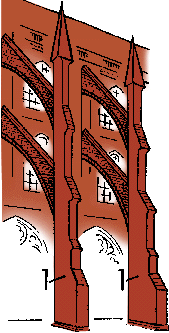
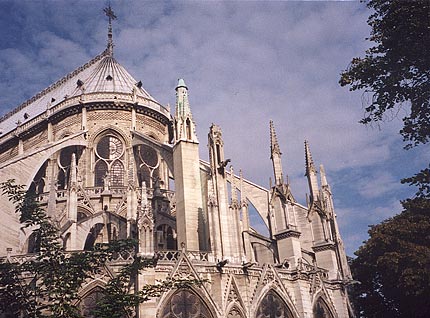
Another difference between les cathedrals Roman and les cathedrals Gothique was the windows. Once the style began to switch to Gothic, and more windows could be put in, designers began to get more creative with it. They began using des vitreux (stained-glass windows), and they also changed the look of the window. In le style Roman, windows were rounded at the top. Le style Gothique featured pointed windows, which is said to be symbolic of reaching towards the Heavens and God, and to be the shape of praying hands. Des vitreux became favored because they "let God's light in," which is why they were all so beautiful. They used des vitreux to tell bible stories, show royalty and donors, and also to show the artisans and the amount of work they put into the cathedral. (Chabot, 2003)
Sculptures and carvings also changed between the two eras. In
le style Gothique, the people became more natural and realistic,and they showed movement and expression. The folds in the clothes even began to look more realistic. Also, as
le style Gothique developed, the carving became mostly people instead of animals, flowers and demons. (Chabot, 2003)
Cathedrals have palyed an important role for the people througout history in France. Not only were Cathedrals a symbol of prosperity and pride, but they were also a storage place's for a person's important documents, magnets for trade and commerce, and the spritual center for the dioces. Also, most of the cathedrals are still used for mass today (Chabot, 2003).
Building a cathedral was not an easy task. Not only did it take years and years to build, but it also took a lot of money, and a lot of support from certain people. One person who had to support the efforts was the bishop. Cathedral actually means Throne of the Bishop, and the bishop was the person who oversaw everything and made sure that the quality of the work was good. Oftentimes, the bishop gave his own money to the cathedral. (Olshaker, 1985)
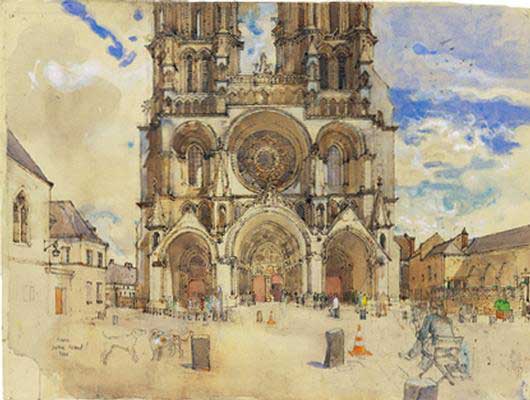
In the movie
Cathedrals, there were two bishops in the town of Beaulieu while the cathedral was being built. The first bishop, Phillipe, was very giving and very kind. He was devoted to the cathedral, helped the homeless, and gave up a lot of his own money to go for the church. However, many of Phillipe's efforts were spoiled when the next bishop, Gervais, followed in his footsteps. Gervais came from a wealthy, prominent family. He was rather greedy, and never gave to the church or to the homeless. He even took more money from the church than what was rightfully his. He also lied and convinced the workers to use weak rocks, which eventually caused the cathedral to collapse. (Olshaker, 1985)
People eventually began to catch onto Gervais, and by persecuting and accusing him, managed to run him out of the town. This is not unsimilar to a real situation that happened in the town of Laon, under bishop Gaudrie. Gaudrie was known to be a corrup bishop who used the cathedral for his own use. This angered the the people, and caused them to storm the palace, where they cut off the bishop's head, then lit fire to the palace and the cathedral. (Olshaker, 1985)
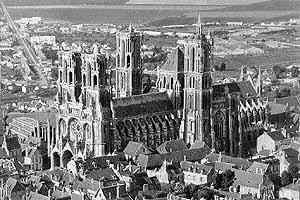
Another important factor of both les cathedrals Roman and les cathedrals Gothique was the collection of relics. A relic is a tangible object that is proof of the Christian story. If a cathedral could attain a relic, they were considered higher than the other cathedrals. People would travel from all over the world to see it. One cathedral with a relic is Amien Cathedral, which claims to have the skull of St. John the Baptist. Saint Chapelle, which was built for King Louis IX (St. Louis), was built for one purpose: to store the Crown of Thorns, which is believed to be the crown that Jesus wore. The fictional town of Beaulieu also had its own relic, the Veil of the Virgin, which had to be saved from the conflagration.(Olshaker, 1985)

Abbot Suger was an influencial cleric. He designed the Royal Abbey Church at Saint Denis, and he believed that God's present was light. He therefore designed the cathedral so the it was virtually surrounded by stained-glass to let in the light. Saint Denis was the first fully-Gothic church to be built in France, and it is considered the
birthplace of Gothic Architechture. It serves as a burial place for French kings and royalty. (Chabot, 2003)
For more information on Romanesque Cathedrals, click here or here.
For more information on Gothic Cathedrals, click here or here.
References
Retrieved May, 2003 from: http://gallery.sjsu.edu/chartres/tour.html
Retrieved May, 2003 from: http://www.beloit.edu/~arthist/historyofart/gothic/bourges.htm
Retrieved May, 2003 from: http://www.orgel.com/laon.html
Chabot, J.E. (2003, May). Class Lecture. Gothic and Romanesque Cathedrals.
Olshaker, Mark; Klien, Larry. "Cathedral." Unicorn projects, Inc. Washington D.C.: 1985.
